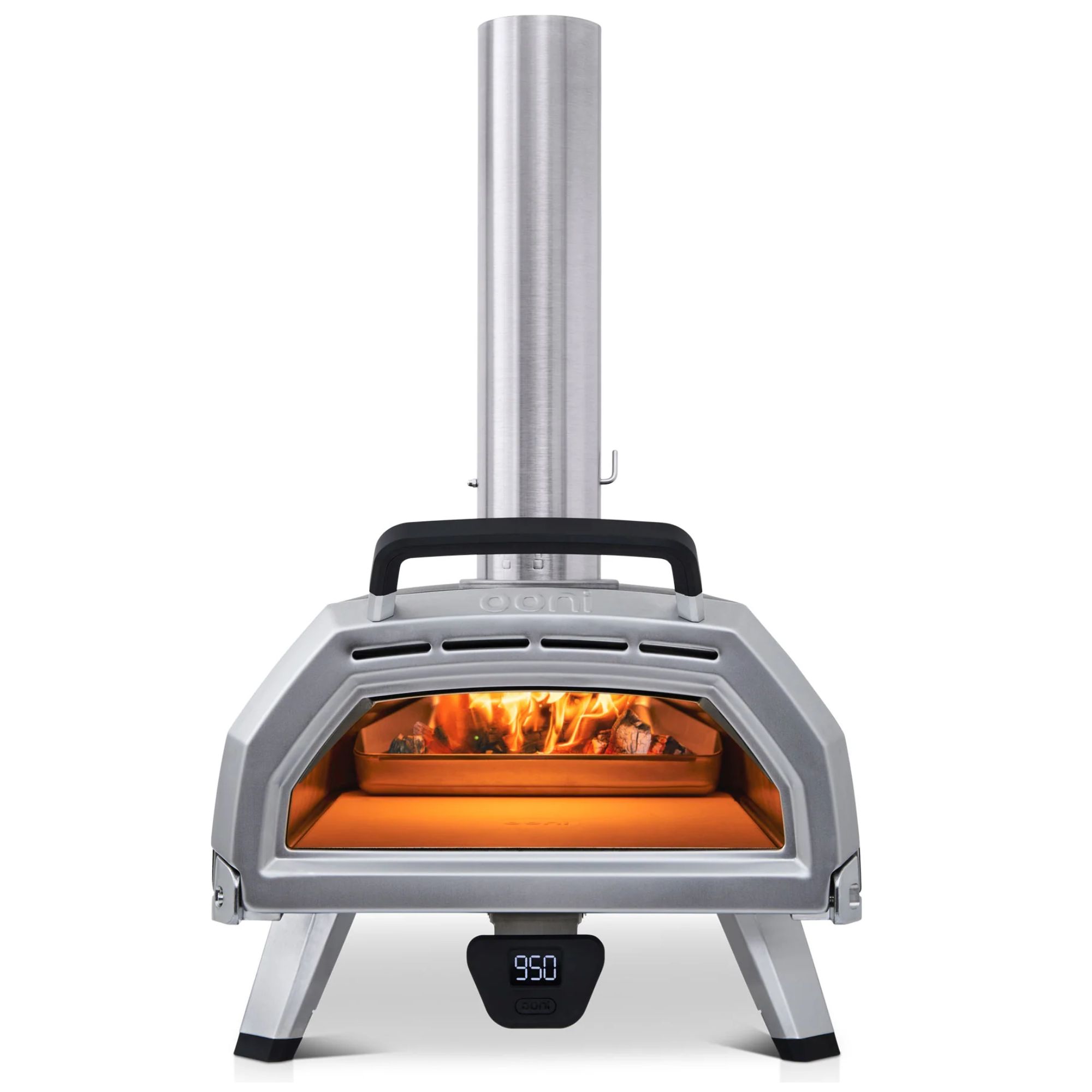
Pizza ovens are among the most expensive appliances in the world. They cost more than stand mixers, fancy coffee makers, and even some large appliances like washing machines and fridges.
The market is saturated with cheap rip-off ovens as well as eye-wateringly expensive premium models. It can be hard to know how to buy a pizza oven because there's so much out there - and it's all so expensive.
As a product tester, I've spent the last few years trying some of the best pizza ovens in the world. This is all you need to know about buying a pizza oven so you don't get ripped off.
1. Set your budget

Pizza ovens have some of the most inflated prices around, so it's smart to set your budget.
Between $150-$350 will get you a good, 12-inch wood-fired pizza oven. It's worth spending towards the top end of this scale. Cheaper models can make amazing pizza, but I've found that lots of them have poor-balanced doors or bad safety features, such as badly insulated handles, or wood pellet drawers that don't shut correctly.
Between $350-$600 will get you a good gas pizza oven. Gas pizza ovens are largely the same, so the difference in price here is mostly a matter of size. A good 12-inch gas pizza oven is around $400; a good 14 or 16-inch gas pizza oven is more like $600. Hybrid gas/wood ovens tend to come in at around this price point, too.
Expect to pay around $700-$800 for a good indoor pizza oven, but I don't always recommend these - more on that below.
For large pizza ovens, or stylized ovens designed to be part of an outdoor kitchen, expect to pay $1000-$2000. These ovens usually hold more than one pizza and have bonus features like meat probes or wood storage.

This was one of the first pizza ovens to enter the market, but it's still fantastic - a fast, simple gas pizza oven.

A stylish oven like this is the perfect focal point for an outdoor kitchen. This is one of the most expensive ovens out there, but it cooks with both wood and gas and includes a meat probe.
2. Decide on your fuel

Once you've set your budget, you can decide which fuel you want to use. There are three types of fuel for powering a pizza oven, and they all have different benefits and drawbacks.
The first type is wood, most commonly as pellets but sometimes as splints. Wood is the best-tasting fuel for a pizza oven. It gets hotter than other types of pizza oven fuel and unlike gas and electricity, the wood imparts an authentic, smoky flavor that can't be beaten by other types of oven. Wood pellets are cheaper to run than gas.
However, wood is hard to maintain at the right temperature, and needs constant monitoring and stoking, which is much more work than the other fuel types. It's more dangerous than other fuel types because you have to feed the pellets or wood splints in by hand. While wood is relatively cheap, there's the ongoing cost and errand of keeping the pellets topped up. Finally, some people don't like the smell of wood smoke.
Gas ovens are much easier to use than wood pellets. Unlike wood pellets, there's no learning curve or stoking. You just hook up your propane and switch on the oven - it's as easy as turning on a grill or a stove.
However, gas is more expensive than any other type of fuel, and compared to wood-fired pizza ovens it tastes a little sterile. Gas ovens can be very hot, but they can't get as hot as wood pizza ovens.
Finally, indoor pizza ovens run on electricity, heating the pizza with an electric filament. This is as easy to use as pressing a button, and by far the cheapest oven to run, but it's not as hot as wood or gas and doesn't taste as good.

It's not the best pizza oven out there, but it's my personal favorite. This wood-fired oven makes incredible pizza without breaking the bank.

This simple gas oven is our favorite. It's incredibly easy to use and makes good pizza - it's all you need for great pizza at home.

I'm not entirely convinced by indoor pizza ovens, but this model has dedicated settings for different styles of pizza. It makes it easy to experiment with different types of pie.
3. Think twice about indoor ovens

If you don't have any yard space, an indoor pizza oven can be a good way to make pizza at home. However, they have significant drawbacks.
Indoor pizza ovens cook with an electric element like a toaster oven. This means that - apart from the pizza stone - there is almost no difference between a good indoor pizza oven and a good toaster oven. The only real difference is that the toaster oven is cheaper and can hold more food.
In turn, that means that indoor pizza ovens aren't as good as outdoor models. There's almost no difference between a pizza cooked in a regular kitchen oven and a pizza cooked in an indoor pizza oven. They don't get hot enough to form a truly crispy crust, there's no smoky flavor, and the bottom of the pizza is often better cooked than the top. It's a lot of money to pay for the same result.
On top of that, indoor pizza ovens are huge - in fact, they're the largest kitchen appliance I've tested. For the sake of balance, I live in a small apartment, but every indoor oven I've tested has taken up at least 1/3 of my countertop, and I have never yet found a way to store them.
All of the above especially applies to cheap, gimmick rotating pizza ovens like this Presto 03430 Pizzazz Plus Rotating Oven at Amazon. It has thousands of positive 5-star reviews, but after testing lots of these I've found that they barely work. You can see in the review images that these rotating ovens make for bad pizzas, with uncooked dough and burnt cheese.
4. Avoid grill top ovens

When shopping for a pizza oven, you'll probably see grill-top pizza ovens like this Cuisinart Grill Top Pizza Oven, available at Amazon. They seem like a good idea because it means you can get a secondary function out of your grill and save a lot of money. However, don't fall for it.
I've tested several of these grill-top ovens and they don't work. It's simple physics. The grill only heats the oven from the bottom, not the top. This means that the base of the crust is incinerated, but the top is totally raw. It makes for pretty gross pizza.
That's if the oven works at all. Grills - especially gas grills - don't get as hot as true pizza ovens. This means that in the worst grill-top ovens, the stone isn't hot enough to cook in. Pizza stones are very porous and absorb moisture, which is what creates the crisp crust. However, if they aren't hot enough, they won't crisp the crust, just suck up the moisture in the dough. This means that the pizza welds to the stone, making for uncooked, sticky dough that is impossible to clean. That isn't hyperbole - once that dough is in there, you can't remove it.
5. Look out for bonus features - but don't let them be deal breakers
There are some essential items needed for using a pizza oven: a pizza peel, a pizza cutter, and a baking tray. A pizza peel is most important because this is the tool you use to load a pizza onto a pizza stone. Without this, you can't use your oven.
However, lots of pizza ovens don't include this as standard, so you have to buy it separately. This is very frustrating, and it's why many people are looking for Ooni alternatives. It can be galling to pay hundreds of dollars for a pizza oven and find you can't use it out of the box.
That said, don't let it be a deal breaker. Other pizza ovens include these features, but they don't make great pizza, so it's still worth sticking to the big brands. While the big brands don't include pizza peels, they often include premium features like digital thermometers.
Once you have your fuel, size, and budget worked out, it's smart to weigh up the big brands, such as Ooni vs Gozney. The summary is that Ooni ovens perform better, but Gozney ovens look much better in an outdoor kitchen.








